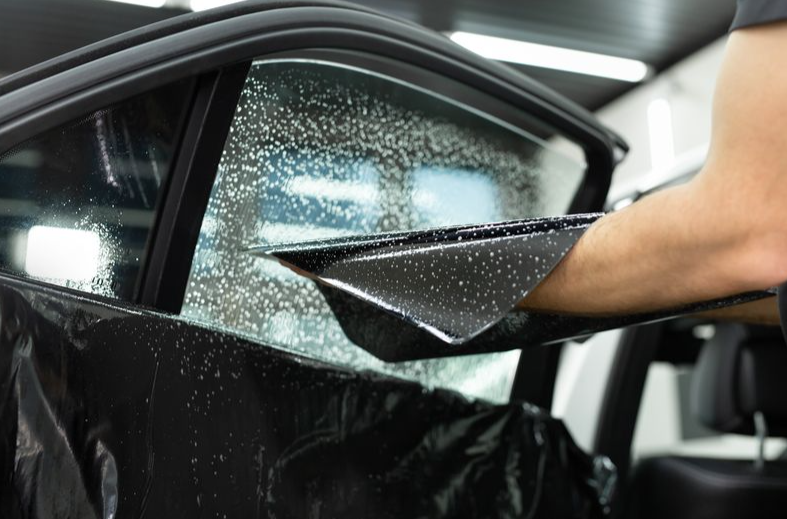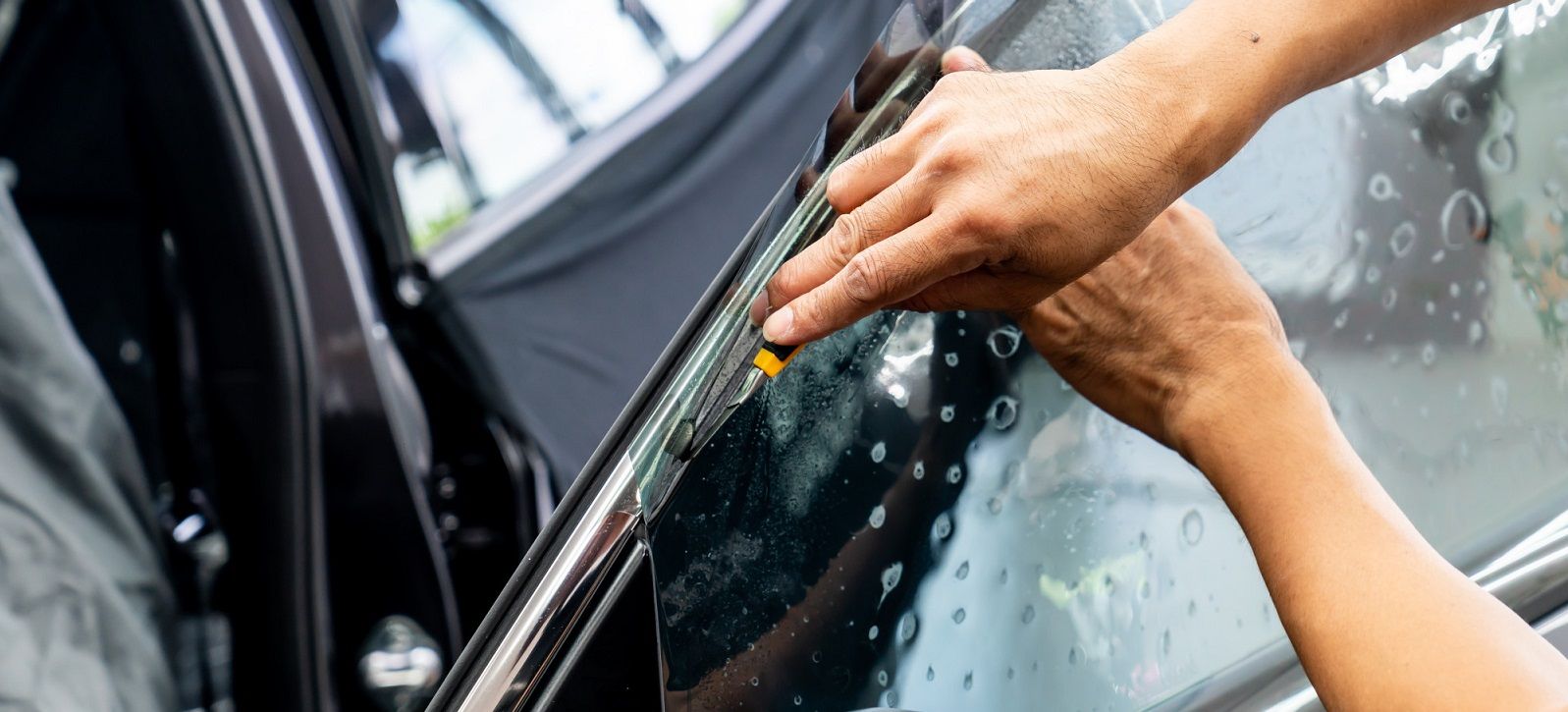A Comprehensive Overview to Understanding Automobile Home Window Tint and Its Benefits
Automobile window tinting serves greater than simply an aesthetic objective for vehicles. It supplies various types, each with distinct attributes and benefits. Recognizing these options, along with legal laws and upkeep suggestions, is important for any car owner. The benefits might substantially boost driving convenience and vehicle longevity. As one explores the subtleties of window tinting, the question emerges: what kind of tint is best matched for individual demands?
Comprehending Car Home Window Color: What It Is and How It Functions
Automobile window tint works as a safety barrier that boosts lorry aesthetic appeals while supplying useful benefits. This slim movie is related to the interior surface area of cars and truck windows, decreasing glare and obstructing damaging ultraviolet (UV) rays from the sunlight. By filtering system sunshine, car home window color aids to regulate the interior temperature of the vehicle, causing raised comfort for passengers and decreased reliance on air conditioning.Additionally, it secures the lorry's inside from fading, maintaining both furniture and control panel products. The color can likewise improve privacy, making it harder for outsiders to see inside the car. In addition, certain sorts of home window tint can raise safety; in case of a crash, the film assists hold destroyed glass together, minimizing the threat of injury from flying shards. Overall, automobile home window color offers both aesthetic and useful purposes, making it a popular option amongst lorry proprietors.
Kinds Of Window Tint: A Review of Options
When considering window tint options, a number of types are offered, each with unique features. Colored, metalized, and ceramic home window colors use varying levels of warm being rejected, UV security, and aesthetic charm. Recognizing these distinctions can assist lorry owners make informed choices based upon their requirements and preferences.
Colored Home Window Tint
Dyed window color stands for a popular selection amongst auto proprietors looking for a reliable and cost effective method to boost their car's aesthetic appeals and privacy. This sort of color is developed by putting a layer of dye in between a protective finish and a sticky layer, resulting in a dark appearance that lowers glare and boosts visual comfort. While colored window tint properly blocks dangerous UV rays, it may not provide the very same degree of heat being rejected as various other color types. In addition, its color can discolor with time, potentially decreasing its effectiveness. Despite these drawbacks, dyed window tint remains preferred for its cost-effectiveness and ability to offer a streamlined, fashionable appearance to various car designs.
Metalized Home Window Tint
Metalized window color supplies a balance of style and capability, making it a popular option amongst car owners. This sort of tint integrates metallic bits within the movie, improving both visual charm and warmth denial. The reflective top quality of metalized color aids to reduce glare and improve privacy, while also providing UV protection, which safeguards the car's interior. Furthermore, metalized window tint can strengthen window strength, potentially stopping smashing throughout mishaps. Nevertheless, it is crucial to keep in mind that the metallic parts can disrupt electronic signals, such as general practitioner and cellular phone reception. On the whole, metalized window tint offers an effective solution for those seeking a mix of appearance, sunlight, and toughness defense for their automobiles.
Ceramic Window Color
Ceramic window tint stands for an advanced alternative in the range of vehicle window films, offering distinct benefits over standard colors. Unlike dyed or metalized films, ceramic tints use innovative ceramic particles, which effectively reject warm and UV rays without jeopardizing visibility. This innovation assures that automobiles stay cooler, minimizing dependence on a/c and enhancing gas effectiveness. In addition, ceramic window colors are less likely to disrupt electronic tools, such as GPS or mobile signals, making them a practical option for modern-day cars. Their longevity and scrape resistance add to a longer life-span compared to other kinds of colors. Overall, ceramic window color provides exceptional efficiency, convenience, and protection, making it a favored choice for critical lorry owners.
Benefits of Automobile Home Window Color: Beyond Appearances
While numerous people associate vehicle window tint with improved style, its advantages prolong much past plain appearances. One considerable advantage is warm reduction; window tint can block as much as 99% of hazardous UV rays, keeping the interior cooler and safeguarding furniture from fading. This not just boosts convenience during hot weather yet likewise minimizes reliance on air conditioning, resulting in enhanced fuel efficiency.In enhancement, auto home window tint provides an included layer of personal privacy and safety and security. Colored windows make it difficult for outsiders to see inside the car, which can prevent theft and protect belongings. Additionally, lots of colors enhance the glass, reducing the probability of shattering in the event of an accident, therefore boosting safety.In enhancement to these practical benefits, vehicle home window color can likewise add to glow reduction, improving exposure for travelers and drivers alike. This multifaceted approach to convenience and security makes important source home window tint a valuable financial investment for automobile owners.
Lawful Considerations: Tinting Regulations by State
Prior to committing to vehicle window color, car owners must browse a complex landscape of tinting regulations that differ by state. Each state has particular legislations regulating the acceptable degrees of tint darkness and reflectivity for various windows, consisting of windscreens, front side windows, and back home windows. These regulations commonly include visible light transmission (VLT) portions, which determine just how much light can pass through the colored glass.Some states allow darker colors on back windows while restricting front side and windshield tints for safety and security factors. Additionally, specific states may call for a certificate from the maker to validate compliance with tinting regulations. Going against these policies can lead to penalties, necessary elimination of the color, or both. Consequently, it is vital for vehicle owners to research their state's legislations extensively to guarantee legal compliance before setting up window color. This persistance can save money and time over time.
Choosing the Right Color: Aspects to Take into consideration
When selecting the suitable window tint for a car, numerous vital aspects come right into play. Tint darkness degrees, UV defense rankings, and compliance with lawful laws are essential considerations to guarantee both looks and performance. Examining these elements will assist individuals make an informed decision that meets their needs and follows local legislations.
Tint Darkness Levels
Picking the appropriate color darkness degree is crucial for attaining the preferred balance in between aesthetics and capability in car home window tinting. Various states have varying legal laws relating to tint darkness, which can influence the option. Typically, tints are measured in percents, with lower percentages showing darker shades. Darker colors provide raised privacy and a streamlined appearance yet can decrease presence, especially at evening. Conversely, lighter tints keep a more open feel, making certain appropriate presence while still offering some warmth and glare decrease. Individuals need to consider their driving habits, regional laws, and personal choices when choosing. Inevitably, the best tint darkness degree enhances the automobile's appearance while ensuring safety and compliance with lawful criteria.
UV Defense Ranking
Tint darkness levels play a considerable function in the total effectiveness of car home window tinting, but one more crucial variable to examine is the UV defense rating of the chosen tint. This ranking shows the portion of damaging ultraviolet rays that the color can block. Top notch colors frequently supply 99% or even more UV security, protecting guests and the vehicle's interior from sunlight damage. Davinci of Michigan. Prolonged exposure to UV rays can result in skin issues and fading of furniture, making a high UV defense ranking crucial for health and wellness and long life. When picking home window color, customers need to prioritize this ranking along with darkness levels to ensure optimum convenience and security while driving. Recognizing these variables help in making an educated choice when purchasing automobile window tinting
Legal Regulations Compliance
Understanding neighborhood lawful guidelines is vital for anyone taking into consideration vehicle home window tinting. Each state or region has particular laws controling the allowable levels of color darkness and reflectivity for various windows. These regulations often define the visible light transmission portion, figuring out how much light can go through the colored glass. Non-compliance can result in fines, required removal of the color, or problems throughout car inspections. Furthermore, some areas might have restrictions on the usage of certain tinting products, requiring consumers to pick products that fulfill security standards. It is crucial for vehicle proprietors to research their neighborhood laws extensively before choosing home window color to assure conformity and stay clear of prospective legal difficulties.

Installation Process: DIY vs. Professional Services
Exactly how does one determine between a DIY installation and employing expert solutions for vehicle window tinting? The choice frequently depends upon budget plan, experience, and wanted outcomes. A do it yourself technique can be cost-efficient, permitting people to save money straight from the source on labor prices. It needs a certain level of skill and expertise concerning the tinting procedure. Those that are careful and individual might discover success with DIY kits available in the market.Conversely, professional solutions provide knowledge and high-grade products, making certain a perfect surface. Experts frequently guarantee their job, giving satisfaction against possible problems such as peeling off or bubbling. Additionally, they recognize with regional laws pertaining to tinting, which can be complicated for the average car owner.Ultimately, the choice shows a balance between price, individual ability, and the anticipated high quality of the tinting job. Each alternative has its advantages, and the ideal option depends on specific situations and choices.
Upkeep Tips: Maintaining Your Tint in Leading Problem

Regularly Asked Inquiries
The Length Of Time Does Window Color Typically Last on a Lorry?
Home window tint typically lasts in between five to 10 years, depending upon aspects such as high quality, application, and ecological problems. Regular upkeep and appropriate treatment can expand its life-span, making sure optimal efficiency and home look in time.
Can Home Window Tinting Damage My Auto's Original Glass?
Home window tinting, when used properly, does not damage a car's initial glass. However, improper installment or low-grade products might lead to issues like peeling or gurgling, possibly affecting the glass's stability in time.
Is Home Window Tinting Safe for All Types of Automobiles?
Window tinting is usually risk-free for a lot of vehicles, supplied the film abides by local policies and is effectively used. Some specific automobiles may require specific considerations, making it crucial to speak with specialists before setup.
Will Home Window Tinting Void My Automobile Warranty?
The question of whether home window tinting voids a vehicle service warranty typically depends upon the maker's plans. Typically, if the color does not harm the lorry, guarantees typically continue to be undamaged. Getting in touch with the dealer is recommended.
Can I Remove Home Window Tint Myself if Needed?
Eliminating window color oneself is feasible, yet it requires cautious focus to stay clear of damaging the glass. People should make use of suitable tools and techniques to ensure a successful removal without leaving glue residue or scratches behind. While colored home window tint efficiently blocks damaging UV rays, it might not offer the same level of warm rejection as other color kinds. Ceramic home window color represents an innovative choice in the spectrum of vehicle home window films, offering distinct benefits over standard tints. Prior to devoting to auto window color, vehicle owners must navigate a complex landscape of tinting laws that vary by state. These policies usually include noticeable light transmission (VLT) portions, which determine exactly how much light can pass with the tinted glass.Some states allow darker tints on back windows while limiting front side and windshield tints for safety and security reasons. Color darkness levels play a significant role in the overall efficiency of vehicle home window tinting, but one more vital factor to evaluate is the UV defense rating of the chosen tint.